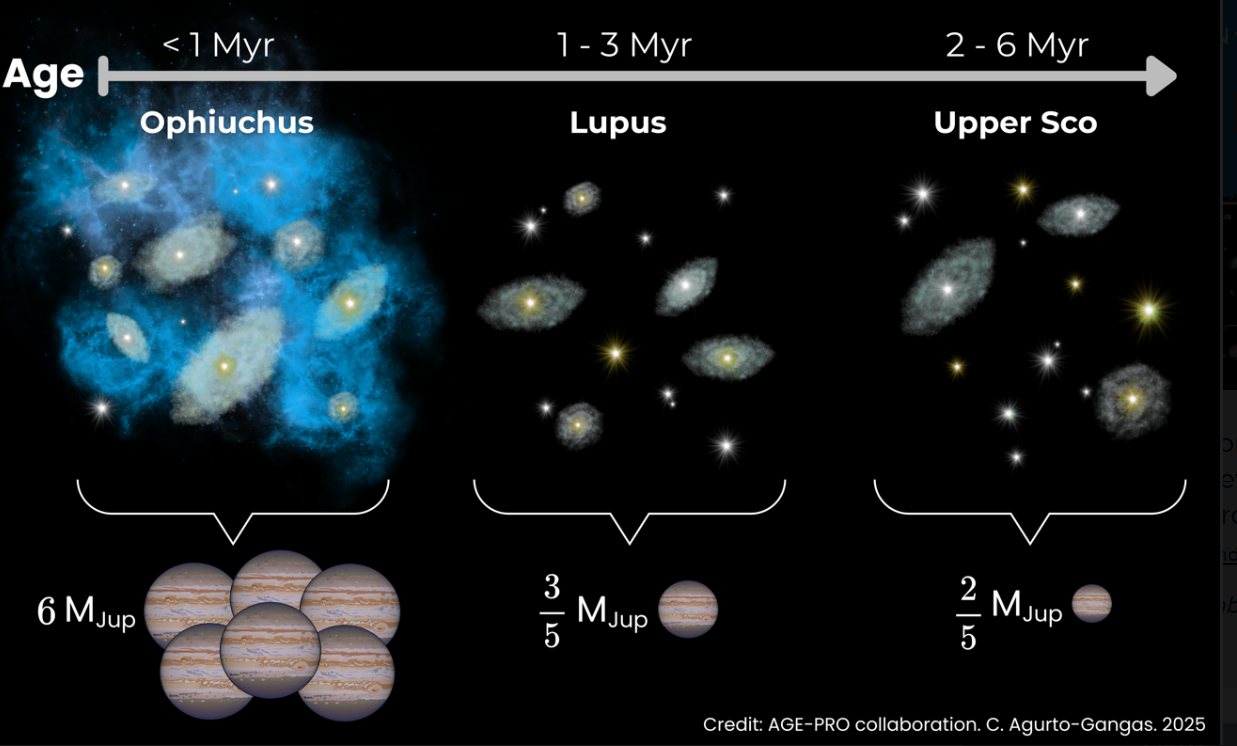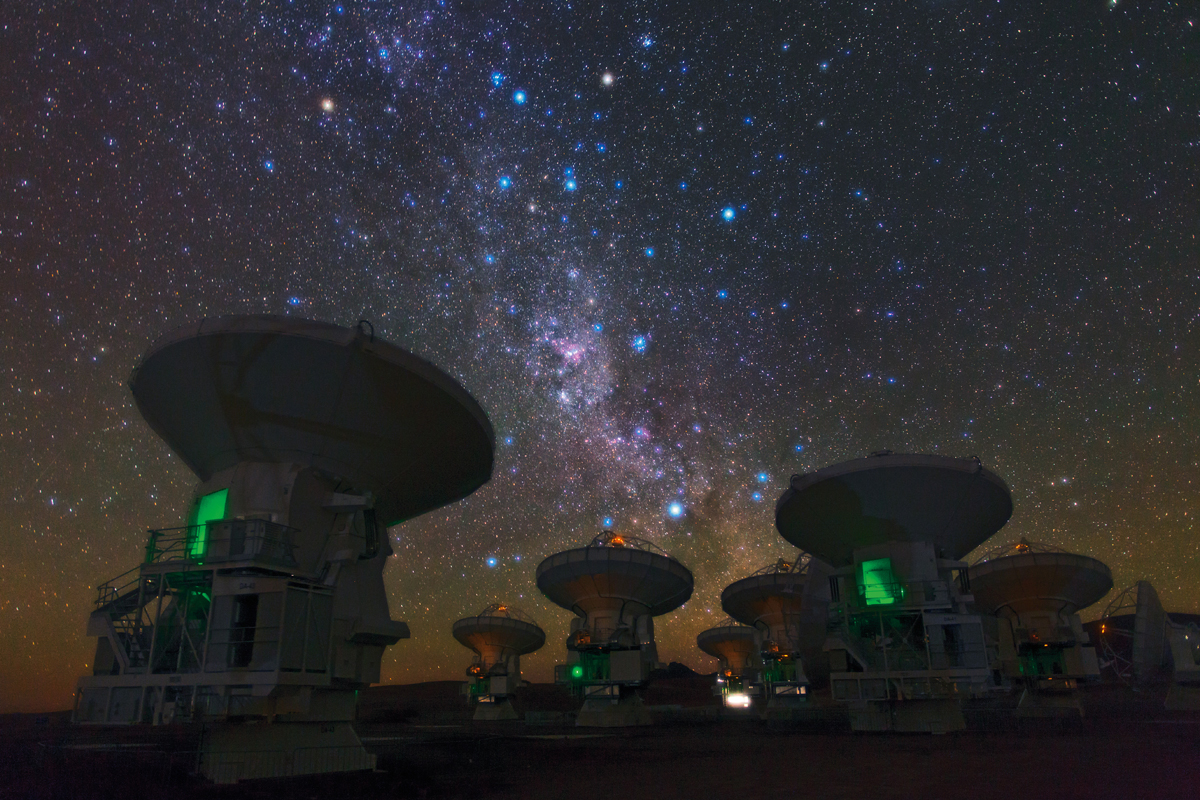Infant planets are ravenous little blighters that quickly devour what remains of the star-circling gas and dust clouds in which they form. The gas in these protoplanetary disks disappears rapidly, within just a few million years. Astronomers now have a better picture of this process of planetary evolution than ever before, thanks to a new study.
The research was conducted by an international team of astronomers using the Atacama Large Millimeter/submillimeter Array (ALMA), as part of a program called the ALMA Survey of Gas Evolution of PROtoplanetary Disks (AGE-PRO). The AGE-PRO team studied 30 protoplanetary disks around sunlike stars, finding that gas and dust components in these disks evolve at different rates. The amount of gas remaining as these disks are whittled away determines the type of planets these systems produce, the researchers found.
The new results could help scientists better understand how planetary systems, including our own solar system, form and evolve.
Indeed, the AGE-PRO results have given rise to a staggering 12 research papers by different research teams, showing just how ground-breaking the discovery is.
“These studies have revealed how protoplanetary disks evolve over time,” AGE-PRO researcher Anibal E. Sierra Morales, of the Mullard Space Science Laboratory at University College London (UCL), said in a statement to Space.com. “The extraordinary results are an essential step toward understanding the initial conditions that lead to the formation of Earth-like planets.”
Telling the story of planet formation
The story of protoplanetary disks begins when clumps of overdense, cool gas collapse under their own gravity in interstellar molecular clouds, birthing stars. These infant stars, or “protostars,” continue to gather matter from their prenatal envelope of gas.
Eventually, what is left behind is a main sequence star surrounded by a flattened, swirling cloud of gas and dust — a protoplanetary disk. Within this disk, conglomerations of material bump together and stick, gathering mass until they form planetesimals. These planetesimals continue to gather material from the protoplanetary disk, and it is from this process that planets grow.
It’s estimated that protoplanetary disks surround infant stars for several million years, and this sets the time that giant planets have available to form.
The initial size and mass of the protoplanetary disk and the speed at which it spins — its angular momentum — determine the kind of planets it is capable of birthing. The lifespan of gas in the disk then determines how long the clumps have to gather and grow into bodies the size of asteroids or planets.
Additionally, these factors can also determine if planets migrate through the planetary disk during their youth, moving from their birthplaces closer to or farther away from their star. This, therefore, determines the final shape that the planetary disk will take.
Before this new study, researchers had analyzed how the dust content of protoplanetary disks evolves, but the way the gas content changes over time was not as well understood.
“AGE-PRO provides the first measurements of gas disk masses and sizes across the lifetime of planet-forming disks,” research principal investigator Ke Zhang, of the University of Wisconsin-Madison, said in a statement.

Using ALMA the team zoomed into 30 protoplanetary disks of different ages, ranging from 1 million years old to over 5 million years old. These disks were located in the star-birthing regions of the constellations Ophiuchus, Lupus and Upper Scorpius.
The sensitivity of ALMA allowed the team to track particular chemical “tracers” that reveal gas and dust masses during vital stages of protoplanetary disk evolution, from initial formation to their inevitable disintegration millions of years later.
While carbon monoxide is one of the most commonly used chemical tracers for astronomers, the AGE-Pro team also relied on the molecule diazenylium. ALMA was also able to detect the chemical signatures of other molecules like aldehyde, deuterated cyanogen and cyanomethane, thus painting a more detailed picture of the chemical evolution of protoplanetary disks than ever before.
“This is the first large-scale chemical survey of its kind, targeting the 30 disks with a broader range of ages to characterize the gas masses,” research co-leader John Carpenter, of the Joint ALMA Observatory, said in the same statement.

The research hints at the timeframes at which gas giant planets like Jupiter and Saturn are born, compared to those for smaller terrestrial worlds like Earth and Mars.
“AGE-PRO reveals that the median average of the gas disk mass goes from several Jupiter masses in the early ages of less than 1 million years to less than a Jupiter mass in the first 1 to 3 million years,” said AGE-PRO researcher Paola Pinilla, of the Mullard Space Science Laboratory at UCL. “This means that disks have the reservoir to form giant planets in the young disks, but as they mature, the fuel for forming giant planets significantly decreases.
“However, it is surprising that the disks that survive for longer times of between 2 million to 3 million years, maintain a very similar gas disk mass as the 1 million to 3-million-years-old examples.”
Another surprise delivered by ALMA was the fact that, as protoplanetary disks age, the gas and dust within them are consumed at different rates. In particular, the ratio of gas to dust undergoes a “swing” as these swirling flattened clouds age.
“The most surprising finding is that, although most disks dissipate after a few million years, the ones that survive have more gas than expected,” Zhang said. “This fundamentally changes our estimation of the atmospheric accretion of planets formed at a later time.”
By comparing AGE-PRO’s observations of gas evolution in protoplanetary disks of different ages to other studies of gas evolution, the team can start to paint a broader and more detailed picture of how planetary systems evolve.
The 12 new papers will be published in a forthcoming issue of The Astrophysical Journal.


